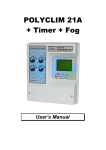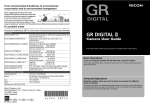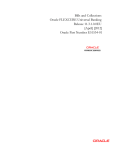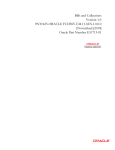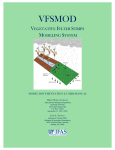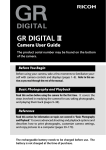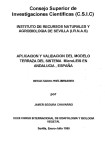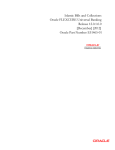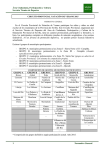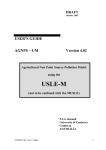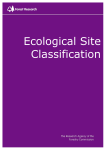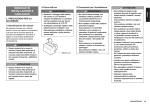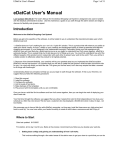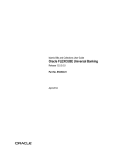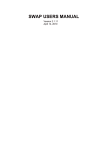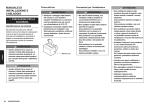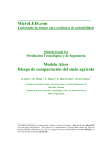Download Ero&Con User`s Manual & Technical Description
Transcript
_____________________________________________ WWW MicroLEIS Exploring the Agro-ecological Limits of Sustainability Ero&Con Agro-ecological Field Vulnerability Evaluation System User's Manual & Technical Description developed by D. de la Rosa, J. Crompvoets, F. Mayol and J.A. Moreno Consejo Superior de Investigaciones Científicas Instituto de Recursos Naturales y Agrobiología Sevilla WWW MicroLEIS Ero&Con module Contents 1. The Approach Overview 2. Ero&Con Front-end 2.1. General Structure 2.2. Installation 2.3. System Requirements 3. Input Data Generation 3.1. Raizal Model 3.1.1. New Evaluating Scenarios 3.1.2. Enter, Edit and Delete Data 3.1.3. SDBm Interface 3.2. Pantanal Model 3.2.1. New Evaluating Scenarios 3.2.2. Enter, Edit and Delete Data 3.2.3. SDBm Interface 4. Base Evaluations 4.1. Raizal Model 4.1.1. Vulnerability Classes 4.1.2. Decision Trees 4.2. Pantanal Model 4.2.1. Vulnerability Classes 4.2.2. Decision Trees 5. Hypothetical Evaluations 5.1. Climate Change 5.2. Management Change 5.3. Climate/Management Change 6. Output Evaluation Results 6.1. Display Results 6.2. Delete Results 7. Bibliography 3 WWW MicroLEIS Ero&Con module 1. The Approach Overview Within the new MicroLEIS framework, the Ero&Con package is a database/expert system evaluation approach for assessing limitations to the use of the land, or vulnerability of the land to specified agricultural degradation risks. Soil erosion, salinization and diffuse agrochemical contamination are separately considered by several program models. These empirical knowledge-based models also combine simple process sub-models such as to predict rainfall erosivity by the ThornthwaiteFournier formula. In this sense, Ero&Con can be considered as a set of hybrid methods. Special attention is given to the management/ technological aspects at farm level. Therefore, agricultural management factors are detailed and combined with land characteristics in order to define the field-units to be evaluated within each model. Physical-attainable risks are calculated separately from management-related risks, and the two are combined to produce the actual vulnerability classes (Figure 1.1). Ero&Con models are automated applications of the developed rural resources databases: SDBm (Soil), CDB (Climate) and MDB (Management) (Figure 1.2). The created expert models are based on decision trees as hierachical multiway keys in which the leaves are results such as land quality (LQ) ratings, and the interior nodes of the tree are decision criteria such as land characteristic (LC) values. The models were partly constructed in accordance with the criteria of the FAO-framework for Land Evaluation. The created models were initially formulated and calibrated by using expert knowledge (experience) of specialists and land users, and collected literature (knowledge). Then the models were recalibrated and validated by point-to-point application using data (information) of 62 representative sites of the Andalucia region, Spain, and of 42 sites of the European Union. A spatial application of the models was made for the Province of Sevilla (1,400,000 ha), Spain. The hypothetical predictions, considering climate and management changes, can be useful as tools in designing adaptation strategies to climate changes and in formulating sustainable landuse scenarios by changing agricultural management practices. These "what-if" scenarios are critical pieces of the puzzle in the understanding of global change. Figure 1.3 shows an overview with the general structure of the Ero&Con system. 4 WWW MicroLEIS Ero&Con module Phase 2 Phase 1 Potentialities: climate site, soil qualities E Attainable land productivity (strategic crops) + c a, b E Biophysical factors data base c Management/ productivity indices R R Sustainability Management factors knowledge base E c Limitations: erosion contamination salinization E Attainable land degradation risks + Application scales: E=European scenarios R=Regional scenarios Actual field suitability classes R Management/ degradation indices R Actual field vulnerability classes Major procedures used: a=Qualitative classification b=Simulation modeling c=Expert systems Figure 1.1. General scheme of the new MicroLEIS framework, incorporating sustainability in land evaluation. 5 WWW MicroLEIS Profile Description Data Ero&Con module Standard Analytical Data Soluble Salts Data Soil Physical Data Language Dictionary Input Data SDBm Soil Layer Generator Coding System Display Data Graphics Representation Printed Data Figure 1.2. General scheme of the SDBm soil database. 6 WWW MicroLEIS Ero&Con module Presentation Main Menu RAIZAL Input Field-Units Delete Data SDBm Interface Scenario Selection Attainable Risks Management Risks PANTANAL Hypothetical Evaluations Original Evaluations Input Data Input Scenarios ARENAL Climatic Change Actual Risks Output Evaluations Management Clim. & Manag. Change Change Evaluation Display Results Delete Results Figure 1.3. The basic structure of Ero&Con front-end. 7 WWW MicroLEIS Ero&Con module Table 1.1 . Input variable list of the Raizal and Pantanal evaluation models. ______________________________________________________________________ Land characteristic, class or unit Raizal Pantanal ______________________________________________________________________ Site-related characteristics LC Landforms, 21 classes xxx xxx LC Slope gradient, % xxx xxx LC Groundwater table depth, m xxx xxx Soil-related characteristics LC Drainage, 7 classes xxx LC Particle size distribution, 23 classes xxx LC Superficial stoniness, % xxx LC Organic matter, % xxx LC pH LC Cation exchange capacity, meq/100g LC Sodium saturation, % xxx Climate-related characteristics LC Mean monthly precipitation, mm LC Max monthly precipitation, mm xxx LC Mean monthly temperature, °C xxx LC Latitude, ° xxx xxx xxx xxx xxx xxx xxx xxx xxx xxx _____________________________________________________________________ 8 WWW MicroLEIS Ero&Con module Table 1.1. (Cont.). Input variable list of the Raizal and Pantanal evaluation models ______________________________________________________________________ Management characteristic, class or unit Raizal Pantanal ______________________________________________________________________ Crop-related characteristics MC Land use type, 11 classes xxx xxx MC Crop rotation, 4 classes xxx xxx MC Land use on slopes, 2 classes xxx MC Growing season length, days xxx MC Leaf duration, 2 classes xxx MC Leaf situation, 2 classes xxx MC Specific leaf area, m2/kg xxx MC Plant height, m xxx MC Maximum rooting depth, m xxx MC Structure of crop, 2 classes xxx Cultivation-related characteristics MC Sowing date, 2 classes xxx MC Tillage practices, 5 classes xxx MC Tillage depth, 2 classes xxx MC Tillage method, 2 classes xxx MC Row spacing, m xxx MC Artificial drainage, 2 classes xxx MC Artificial groundwater level, 2 classes MC Soil conservation techniques (water), 4 classes xxx MC Soil conservation techniques (wind), 5 classes xxx MC Residues treatment, 3 classes xxx Fertilizer-related characteristics MC Use of P-fertilizer, 3 classes MC Use of N-fertilizer, 3 classes MC Use of animal manure, 2 classes MC Use of industrial /urban waste, 2 classes MC Time of fertilization, 2 classes xxx xxx xxx xxx xxx xxx xxx xxx xxx xxx xxx Pesticides-related characteristics MC Use of pesticides, 2 classes xxx MC Persistence of pesticides, 3 classes xxx MC Toxicity (LD-50) of pesticides, 3 classes xxx MC Application methods, 2 classes xxx _____________________________________________________________________ 9 WWW MicroLEIS Ero&Con module 2. Ero&Con Front-end 2.1. General Structure Following the scheme of the MicroLEIS system, a set of computer programmes was developed to automate the application of Ero&Con models. However, new facilities are included in this package. The major characteristics of the Ero&Con front-end are: - Interface with SDBm database (FAO-CSIC 1994, multilingual Soil Database) - "Pop up" screens showing codes, types and classes - Batch processing modes - Hypothetical predictions option - Link with GIS These programmes are largely self explanatory. They use menus, as shown in Table 2.1, to inform about alternatives, and prompt you to respond whenever needed. From each menu, the "Explanation" option gives detailed information on the corresponding step. Many fields in Ero&Con input screens use codes. These codes are included in the Ero&Con software in the form of indices, and can be accessed from the <F1> key while entering/editing data. Output results for an evaluating scenario in tabular, graphic or CSV format presentation can be displayed or deleted by selecting the corresponding file. Table 2.1. Main menu of the Ero&Con Agro-vulnerability Field Evaluation system. _____________________________________________ MAIN MENU _____________________________________________ 1 RAIZAL model: Soil Erosion 2 ARENAL model: General Soil Contamination 3 PANTANAL model: Specific Soil Contamination H Explanation Q Quit ______________________________________________ 10 WWW MicroLEIS Ero&Con module 2.2. Installation Ero&Con is simple to install and to run. Installation is by the following steps, during which a few questions are asked: - insert the diskette #1 in drive A: (or B: or ...) - change to drive A: (or B: or ...) - type "MLEROINS" to install the software on a hard disk - follow the instructions on the screen Ero&Con will be installed in directory \MLERO Finally, to run Ero&Con from the directory \MLERO, type MLERO and press <Enter>. A few examples of evaluating-scenarios are included. 2.3. System Requirements To use Ero&Con you will require a personal computer (PC), MS-DOS version 3.0 or higher, with about 1 Mbytes of free space. It will work with 1 Mbytes of RAM but is likely to be slow if handling large quantities of data. 11 WWW MicroLEIS Ero&Con module 3. Input Data Generation 3.1. Raizal Model On the main menu of the Raizal model (Table 3.1), the first option is "Input Data Generation". Table 3.1. Main menu of the soil erosion risks: Raizal model ___________________________________________ SOIL EROSION RISKS ___________________________________________ 1 2 3 4 Input Data Generation Base Evaluations Hypothetical Evaluations Output Evaluation Results H Explanation R Return to Ero&Con Menu ____________________________________________ 3.1.1. New Evaluating Scenarios As presented in Table 3.2, the first option of input data is the creation of evaluating-scenarios. To develop a Raizal application it is necessary to define the evaluating-scenario with its internal code locating all the evaluating-units to be evaluated. The number of evaluating-units within an evaluating-scenario is almost unlimited. It is also possible to select a previously defined evaluating-scenario by using the <F1> option. 12 WWW MicroLEIS Ero&Con module Table 3.2. Input data generation menu of Raizal model _________________________________________ INPUT DATA GENERATION _________________________________________ 1 2 3 4 New Evaluating-scenarios Enter & Edit Data Delete Data SDBm Interface H Explanation R Return to Main Menu RAIZAL __________________________________________ For each evaluating-scenario, the input data can be generated i) from the keyboard, for soil-, climate- and management-related data; and ii) through the SDBm interface, only for the soil-related data. 3.1.2. Enter, Edit and Delete Data From the keyboard, it is possible to enter, edit and delete input data. Table 3.3 shows an example of "Enter and Edit Data" screen for soil-related data. The same structure is uded in climate- and management-related variables screens (Table 3.4 and Table 3.5). From all climate data input, the model calculates automatically the Humidity Index and the Derived Fournier/ Humidity Index. These calculated climate variables represent the climate erosivity of a land unit. Table 3.3. Data input screen for soil-related input variables _______________________________________________________________________________ MicroLEIS: Ero&Con RAIZAL Model ____________________________________________________________________________________________________ 13 WWW MicroLEIS Ero&Con module ENTER AND EDIT DATA ________________________________________________________________________________________ Evaluating-scenario: Evaluating-unit: F-AL01 Code Benchmark Soil: AL01 AND Representative area, km2: 2000.00 Name Longitude Latitude Altitude, m Greda-roja W00218 N3717 1260 SOIL-RELATED CHARACTERISTICS Landforms MO Slope Gradient, % Particle Size Distribution 30 Groundwater Table Depth, m 20.0 Superficial Stoniness,% SL Organic Matter,% 1.3 Sodium Saturation,% 5.0 25 Drainage W ________________________________________________________________________________________ Table 3.4. Data input screen for climate-related input variables _______________________________________________________________________________ MicroLEIS: Ero&Con RAIZAL Model _______________________________________________________________________________ Evaluating-Unit: F-AL01 Evaluating-Scenario: AND Code Name Climate Station: AAL01 Almanzora-Alto Longitude Latitude Altitude W00245 N3725 1200 CLIMATE-RELATED CHARACTERISTICS JAN FEB MAR APR MAY JUN JUL AUG SEP OCT NOV DEC Pmax 58.0 62.0 170.0 180.0 122.0 85.0 59.0 82.0 72.0 131.0 158.0 191.0 Pmean 25.0 23.0 40.0 48.0 42.0 28.0 7.0 6.0 15.0 42.0 46.0 56.0 Tmean 4.6 5.6 7.7 10.2 15.0 18.0 23.3 23.0 ________________________________________________________________________________________ Pmax: Maximum Precipitation, mm Pmean: Mean Precipitation, mm Tmean: Mean Temperature, °C Table 3.5. Data input screen for management-related input variables _____________________________________________________________________ MicroLEIS: Ero&Con RAIZAL Model ________________________________________________________________________________ 14 WWW MicroLEIS Ero&Con module Evaluating-unit: F-AL01 Field Utilization Type: Evaluating-Scenario: AND Code Name FUT01 Wheat/Intensive MANAGEMENT-RELATED CHARACTERISTICS Crop Properties Cultivation Practices Land Use Type 1 Sowing Date Growing Season Length, days 180 Tillage Practices Leaf Duration 2 Tillage Depth Leaf Situation 2 Tillage Method 2 Specific Leaf Area, m2/kg 1 Row spacing, m 0.40 Plant Height, m 0.50 1 1 1 Artificial Drainage 2 Maximum Rooting Depth, m 1.00 Soil Conservation Techniq.,Water Structure of Crop 2 Soil Conservation Techniq.,Wind 1 2 Residues Treatment 3 Crop Rotation 4 _______________________________________________________________________________________ The <F1> key can be used for each qualitative variable. It displays on-screen all the possible valid codes and their meaning for this particular characteristic (Table 3.6). Any code can be selected using the cursor and that code is automatically introduced into the variable field. Table 3.6. "Pop up" window for the qualitative land characteristic "Drainage" which opens when pressing the <F1> key ________________________________ LC Surface Drainage ________________________________ V Very poor P Poor I Imperfect M Moderately well W Well S Somewhat excessive E Excessive ________________________________ Appendix A lists the names and classes of all variables (Land Characteristics, LCs; and Management Characteristics, MCs) used within the Raizal model. 15 WWW MicroLEIS Ero&Con module Within the Raizal framework, it is possible to delete an evaluating-scenario or evaluating-unit. Table 3.7 shows the option to delete an evaluating-scenario or unit. Table 3.7. Menu to delete the evaluating scenario or unit. ____________________________ DELETE INPUT DATA ______________________________ 1 2 Delete Evaluating Scenario Delete Evaluating Unit H R Explanation Return to Input Menu ______________________________ 3.1.3. SDBm Interface The soil-related data used as diagnostic criteria in Raizal can be automatically captured from the SDBm database (FAO-CSIC, 1994) by using the "Soil Layer Generator" option of SDBm. When useing this option, the input files generated by SDBm must be placed in directory C:\MLERO\INPUT to be imported. The soil profile variables stored in SDBm which are used in Raizal are the following: 1. Site characteristics: - Latitude, [LAT] - Longitude, [LON] - Altitude, [ELEV] - Land form, [LAFO] - Slope gradient, [SLGR] - Stoniness, [STON] - Drainage, [DRAI] - Ground water table depth, [GWAT] - Location, [LOC] 2. Horizon (layer) characteristics: - Texture, [TEX1] - Organic carbon, [OC] - Cation exchange capacity, [CECS] - Sodium saturation, [NA] 16 WWW MicroLEIS Ero&Con module The structure of SDBm files as created by the "Soil Layer Generator" is shown in Example 3.1. For this example a layer or control section of 0 to 50 cm from the surface was considered for the soil horizon and analytical characteristics. Example 3.1. An SDBm input file, for six soil profiles and one control section, including the SDBm soil-related characteristics which are diagnostic criteria for the Raizal module. _____________________________________________________________________ Reg PRNO LAT LON ELEV LAFO SLGR STON DRAI GWAT LOC TEX1 OC CECS NA ________________________________________________________________________________________ 1 SE0052 N374715 W054015 320 HI 6 C W 0 Constantina SIC 1.25 23.6 0.0 2 SE0058 N374300 W060600 490 VA 3 F W 5 Almaden SIC 1.21 3 SE0059 N374520 W060020 400 VA 4 F M 5 Castilblanco SCL 0.84 21.1 0.0 4 SE0060 N374341 W055629 350 VA 3 V M 5 Castilblanco LS 0.82 10.6 0.1 5 SE0061 N374044 W060218 200 MO 7 C S 0 Castilblanco SL 2.52 20.0 2.0 6 SE0064 N375204 W060524 490 VA 4 F W 5 Almaden 1.69 12.6 0.3 SL 8.5 0.0 _______________________________________________________________________________________ 3.2. Pantanal Model On the main menu of the Pantanal model (Table 3.8), the first option is "Input Data Generation". 17 WWW MicroLEIS Ero&Con module Table 3.8. Main menu of the Pantanal model. _________________________________________________ AGROCHEMICAL CONTAMINATION RISKS _________________________________________________ 1 2 3 4 Input Data Generation Base Evaluations Hypothetical Evaluations Output Evaluation Results H Explanation R Return to Ero&Con Menu _________________________________________________ 3.2.1. New Evaluating Scenarios As presented in Table 3.9., the first option of input data is the creation of new evaluating scenarios. To develop a Pantanal application it is necessary to create an evaluating-scenario with its code within located all the evaluating-units to be evaluated. The number of evaluating-units within an evaluating-scenario is almost unlimited. It is also possible to select a previously defined evaluating-scenario by using the <F1> option. Table 3.9. Input data generation menu of Pantanal model _______________________________________ INPUT DATA GENERATION _______________________________________ 18 WWW MicroLEIS Ero&Con module 1 2 3 4 New Evaluating Scenarios Enter & Edit Data Delete Data SDBm Interface H Explanation R Return to main menu _______________________________________ For each evaluating-unit, the input data can be generated i) from the keyboard; for soil-, climate- and management-related data; and ii) through the SDBm interface, only for the soil-related data. 3.2.2. Enter, Edit and Delete Data From the keyboard, it is possible to enter, edit and delete input data. Table 3.10 shows an example of "Enter and Edit Data" screen for soil-related data. The same structure is used in climate- and managment-related variables screens (Table 3.11 and Table 3.12). Only those variables which are necessary to evaluate the chosen specific compound vulnerability are highlighted on the screens. From all climate data input, the model calculates automatically the Humidity Index, Annual Temperature and Annual Rainfall. These calculated climate variables represent the climate influence on the contamination vulnerability of a land unit. Table 3.10. Data input screen for soil-related input variables MicroLEIS: Ero&Con PANTANAL Model ______________________________________________________________________ ENTER AND EDIT DATA ______________________________________________________________________ 19 WWW MicroLEIS Ero&Con module Evaluating-scenario: AND Evaluating-unit: F-AL01 Benchmark Soil: Representative area, km2: 2000.00 Code Name AL01 Greda-roja Long W 00218 Latit N3717 Altit 1260 SOIL-RELATED CHARACTERISTICS Landform Slope Gradient, % Groundwater Table Depth, m MO 30 W Drainage Particle Size Distribution Organic Matter, % pH C.E.C., meq/100 gr. W SCL 1.7 7.1 18.1 Table 3.11. Data input screen for climate-related input variables MicroLEIS: Ero&Con PATANAL Model ______________________________________________________________________ ENTER AND EDIT DATA ______________________________________________________________________ Evaluating -unit: F-AL01 Evaluating Scenario: AND Code Name Climate Station AAL01 Almanzora-Alto (Baca Long W00245 Latit N3725 Altit 1200 CLIMATE-RELATED CHARACTERISTICS Pmen Tmen JAN 25.0 4.6 FEB MAR APR MAY JUN 23.0 40.0 48.0 42.0 5.6 7.7 10.2 15.0 JUL AUG SEP OCT NOV DEC 28.0 7.0 6.0 15.0 42.0 46.0 18.0 23.3 23.0 18.4 13.6 7.7 56.0 4.8 ______________________________________________________________________ Pmen = Mean Precipitation, mm Tmen = Mean Temperature, °C Table 3.12. Data input screen for management-related input variables _____________________________________________________________________ MicroLEIS: Ero&Con PANTANAL model ______________________________________________________________________ ENTER AND EDIT DATA 20 WWW MicroLEIS Ero&Con module ______________________________________________________________________ Evaluating-unit: F-AL01 Field Utilization Type: Land Use Type Crop Rotation Land Use on Slopes P-Fertilizer N-Fertilizer Animal Manure Industrial/Urban Waste Time of Fertilization Evaluating-scenario: AND Code Name FUT01 Wheat/ Intensive MANAGEMENT-RELATED CHARACTERISTICS 11 Use of Pesticides 4 Persistence of Pesticides 1 Toxity (LD-50) of Pesticides Application methods of Pesticides 2 1 2 2 1 Artificial Drainage Artificial Groundwater Level Residues Treatment Soil Conservation Techniques Tillage Practices 1 2 400 2 2 2 3 4 4 ______________________________________________________________________ The <F1> key can be used for each qualitative variable. It displays on-screen all the possible valid codes and their meaning for this particular characteristic (Table 3.13). Any code can be selected using the bar and that code is automatically introduced into the variable field. Table 3.13. "Pop up" window corresponding to the qualitative land characteristic "Drainage" which opens when pressing the <F1> key. ___________________________ LC DRAINAGE ___________________________ V Very poor P Poor I Imperfect M Moderately well W Well S Somewhat excessive E Excessive ___________________________ Appendix A lists the names and classes of all variables (Land Characteristics, LCs; and Management Characteristics, MCs) used within the Pantanal model. Within the Pantanal framework, it is possible to delete an evaluating scenario or evaluating unit. Table 3.14 shows the option to delete an evaluating scenario or unit. 21 WWW MicroLEIS Ero&Con module Table 3.14. Menu to delete the evaluating scenario or unit. _________________________________ INPUT DATA DELETE _________________________________ 1 2 3 4 5 Evaluating Scenario Evaluating Unit Benchmark Soil Climate Station Field Utilization Type R Return to Input Menu _________________________________ 3.2.3. SDBm Interface The soil-related data used as diagnostic criteria in Pantanal can be automatically captured from the SDBm database (FAO-CSIC, 1994) by using the "Soil Layer Generator" option of SDBm. When using this option the input files generated by SDBm must be placed in directory C:\MLERO\INPUT to be imported. The soil profile variables stored in SDBm which are used in Pantanal are the following: 1. Site Characteristics: - Latitude, [LAT] - Longitude, [LON] - Altitude [ELEV] - Landform [LAFO] - Slope Gradient [SLGR] - Stoniness [STON] - Drainage [DRAI] - Depth of Groundwater Table [GWAT] - Location [LOC] 2. Horizon (layer) and Analytical characteristics: - Texture [TEX1] - pH water [PHW] - Organic carbon [OC] - Cation Exchange Capacity [CECS] - Sodium saturation [NA] 22 WWW MicroLEIS Ero&Con module The structure of SDBm files as created by the "Soil Layer Generator" is shown in Example 3.2. For this example a layer or control section from 0 to 50 cm from the surface was considered for the soil horizon and analytical characteristics. Example 3.2. An SDBm input file for six soil profiles and one control section, including the SDBm soil-related characteristics which are diagnostic criteria for the Pantanal model. _____________________________________________________________________________________________________ PRNO LAT LON ELEV LAFO SLGR STON DRAI GWAT LOC TEX1 PHW OC CECS _____________________________________________________________________________________________________ SE052 N374715 W054015 320 HI 6 F W 0 SIC 5.8 1.3 SE058 N374300 W060600 490 VA 3 F W 5 SIC 5.5 1.2 23.6 8.5 SE059 N374520 W060020 400 VA 4 V M 5 SCL 5.9 0.8 21.1 SE060 N374341 W055629 350 VA 3 F M 5 LS 6.0 0.8 0.6 SE061 N374044 W060218 200 MO 7 C S 0 SL 6.1 2.5 20.0 SE064 N375204 W060524 490 VA 4 V W 5 SL 6.0 1.7 2.6 _____________________________________________________________________________________________________ 23 WWW MicroLEIS Ero&Con module 4. Base Evaluations Ero&Con models evaluate the vulnerability risks of an agricultural field to land degradation, considering separately three types of vulnerability: attainable, management and actual; and for each degradation factor: water and wind erosion; and nitrogen, phosphorus, heavy metals (Cu, Zn, Cd, Hg, Pb) and pesticides (general, hydrophile and hydryphobe) contamination (Table 4.1). The attainable vulnerability considers the biophysical risk of the capability of the soil being harmed in one or more of its ecological functions. The management vulnerability considers the risk of a particular Field Utilization Type to land degradation. The actual vulnerability considers simultaneously the biophysical and management risk factors of a particular field unit. Table 4.1. Combination of vulnerability classes according to attainable, management and actual degradation risks Land degradation Vulnerability type ______________________________________________ factor Attainable risk Management risk Actual risk ______________________________________________________________________ Raizal model Water erosion, W VAW VMW VCW Wind erosion, D VAD VMD VCD VMP VCP Pantanal model Phosphorus contamination, P VAP Nitrogen contamination, N VCN VAN VMN Heavy metals contamination, H VAH VMH VCH Pesticides contamination, X VAX VMX VCX Any type of the evaluation is made in batch-running mode for all the evaluatingunits included within the selected evaluating-scenario. So, the option "Scenario Selection" of Table 4.2 is the first step in making an evaluation. Having selected the scenario, the type of vulnerability which you want to evaluate is chosen. 24 WWW MicroLEIS Ero&Con module Table 4.2. Menu to compute original evaluations of RAIZALmodel. _________________________________ ORIGINAL EVALUATIONS _______________________________________ 1 2 3 4 Scenario Selection Attainable Vulnerability Management Vulnerability Actual Vulnerability T Decision Trees Observation R Return to Main Erosion Menu ______________________________________ 4.1. Raizal Model 4.1.1. Vulnerability Classes The soil erosion vulnerability classes (10) established by Raizal for the Attainable and Actual Vulnerability risks (VAW, VAD and VCW, VCD) are defined as follows: Class V1 None. These field units are not vulnerable to water or wind erosion the risks to these processes could be considered as nil and the land unit will be uneroded. For these fields, management erosivity is not considered to be a controlling factor and almost any farming system can be implemented. Class V2 Very Low. These field units present a very low vulnerability to wind or soil erosion. Soil erosion will occur rarely and only during extreme climate conditions. For these fields the influence of the management systems on the soil degradation is low. 25 WWW MicroLEIS Ero&Con module Class V3 Low. These field units present a low vulnerability to water or wind erosion. Soil erosion will occur rarely. The soil could have a few rills or places with thin A horizons that give evidence of accelarated erosion, but not to such an extent as to alter greatly the thickness and character of the A horizon. The wind will remove only a very small amount of the soil. For these fields the effect of management change on the vulnerability classes could be important. There are no differences in use capabilities and management requirements from the uneroded soils. Class V4 Moderately Low. These field units present a moderately low vulnerability to wind or wind erosion. Only a few properties of water erosion (especially inter-rill erosion) will be visible in the field. The soil of the areas in this class can be eroded to the extent that ordinary implements reach through the remaining A horizon. The wind will remove a small amount of the soil. For these fields the effect of management change on the vulnerability classes could be important. There are small differences in use capabilities and management requirements from the uneroded soils. Class V5 Slightly Low. These field units present a slightly low vulnerability to water or wind erosion. The soil will erode to the extent that ordinary tillage implements reach through the remaining A horizon, or well below the depth of the original plowed layer in soils with thin A horizons. Generally, the plow layer will consist of a mixture of the original A horizons and underlying horizons. Mapped land units will have patches in which the plow layer consists wholly of the original A horizon and others in which it consists wholly of underlying horizons. A few shallow gullies will be present in the field. The wind will remove from the soil a sufficient amount of the A horizon that ordinary tillage brings up. For these fields the effect of management change on the vulnerability classes could be considerable. Class V6 Slightly High. The field units present a slightly high vulnerability to water or wind erosion. The soil will erode to the extent that a big part of the original surface soil, or A horizon, will be removed. Water erosion processes will be active during each year. Numerous shallow gullies will be present in the field. The wind will remove from the soil a large amount of the A horizon that ordinary tillage brings up and will partly mix the B horizon or other underlying horizons with surface soil in the plow layer. Rarely will this be condition uniform throughout a mappable land unit. For these fields the effect of management change on the vulnerability classes could be considerable. Class V7 Moderately High. These field units present a moderately high vulnerability to water or wind erosion. The soil will erode to the extent that practically all of the original surface soil, or A horizon, will be removed. The plow layer will consist essentially of materials from the B or other underlying horizons. Patches in which the plow layer is a mixture of the original A horizon and the B horizon or other underlying horizons will be included within the mapped field units. Shallow gullies, or a few deep ones, will be common on some soil types. 26 WWW MicroLEIS Ero&Con module The wind will remove all of the A horizon and a small amount of the B or other underlying horizon. The plow layer will consist of original horizons below the A horizon. For these fields the more management-erosive farming systems have adverse effects on the environment. Class V8 High. These field units present a high vulnerability to water or wind erosion. The soil will erode to the extent that all of the original surface soil, or A horizon, will be removed. The plow layer will consist essentially of materials from the B or other underlying horizons. Patches in which the plow layer is a mixture of the original A horizon and the B horizon or other underlying horizons will be included within the mapped field units. Shallow and moderately deep gullies will be present in the field unit. Where land is afforested or drained there will be often a "slug" of erosion before channels are stabilized by vegetation, but the rates of erosion will continue to be greater than those prevailing before. The wind will remove all of the A horizon and a part of the B or other underlying horizon. The plow layer will consist mainly of the original horizons below the A (or below the original plowed layer in the soils with thin A horizons), although some patches will have much of the original A horizon remains in the field unit. Sometimes an occasional blow-out area of the field unit will be included. For these fields the more management-erosive farming systems have adverse effects on the environment. Class V9 Very High. These field units present a very high vulnerability to water or wind erosion. The field will erode until it has partly an intricate pattern of moderately deep gullies. Soil profiles will be destroyed except in small areas between gullies. Such fields will not be useful for crops in this condition. Reclamation for crop production or for improved pasture is difficult but will be practical if other characterisics of the soil are favorable and erosion is controlled. The wind will remove a big part of the soil profile. The plow layer consists of the original horizons below the A-horizon. An occasional blow-out part of the field unit will be included. Class V10 Extreme. These field units present an extremely high vulnerability to water or wind erosion. The field will erode until it has an intricate pattern of moderately deep or deep gullies. Soil profiles will be destroyed except in small areas between gullies. Such fields will not be useful for crops in this condition. Reclamation for crop production or for improved pasture is very difficult but will be practical if the other characteristics of the soil are favorable and erosion is controlled by soil conservation techniques, for example by construction of terraces. The assessment of the soil erosion management vulnerability (VMW and VMD) is classified into four classes: Class V1 Very Low. The human influence on these field units is very small regarding the vulnerability to water or wind erosion. In general, this class represents good soil conservation methods and the actual vulnerability of a field unit will be dependent only on the attainable risk. This class represents the best field management 27 WWW MicroLEIS Ero&Con module methods for a particular field unit to become a possible sustainable land use system (economical issues are not involved). Class V2 Moderately Low. The influence of field management is small regarding water or wind erosion vulnerability. In the sense of sustainable land use, when the attainable risk is high then the risk of field management has to be Class 1 or Class 2 (land use with higher vulnerability is excluded). Class V3 Moderately High. Field units with this risk class are in danger of becoming less suitable in the agricultural sense and their field methods are vulnerable to water or wind erosion. The field use with this management risk is considered not to be sustainable. Class V4 Very High. Field units with this management class are in real danger of becoming unsuitable, because their management methods greatly accelerate the processes of water or wind erosion. To sustain the field it is necessary to avoid this management class. Besides vulnerability classes, subclasses are also presented as evaluation outputs. The subclasses show the user the vulnerability limitations of the evaluated field unit and help in understanding the evaluated classification. 4.1.2. Decision Trees The classes of each Land Characteristic (LC) or Management Characteristic (MC) are connected with the severity levels of the corresponding Land Quality (LQ) or Management Quality (MQ) by complex decision trees, based on the approach of expert systems. The connections between the severity levels of the Land and Management Qualities and the vulnerability classes of the Attainable, Management and Actual types are through decision trees (Table 4.3). Appendix A shows the different classes of the Land and Management Characteristics. The following Land and Management Qualities are involved: Land Qualities (with their subclass code) LQ1 Relief, t LQ2 Soil erodibility to water erosion, k LQ3 Rainfall erosivity, r LQ4 Soil erodibility to wind erosion, e Management Qualities (with their subclass code) MQ1 Crop properties to water erosion, o MQ2 Cultivation practices to water erosion, z MQ2.1 Cultivation practices to water erosion: soil, x MQ2.2 Cultivation practices to water erosion: plant, y MQ3 Crop properties to wind erosion, c MQ4 Cultivation practices to wind erosion, u MQ4.1 Cultivation practices to wind erosion: soil, s 28 WWW MicroLEIS Ero&Con module MQ4.2 Cultivation practices to wind erosion: plant, p Almost all the Land and Management Qualities separate four severity levels, as follows: Very low Moderately low Moderately high Very high The whole Raizal model is based on 19 decision trees (Figure 4.1). All the decision trees can be observed by selecting the option "Decision Trees Observation" from the Original Evaluation Menu, and are presented in Appendix B. _________________________________________________________________________________ MicroLEIS: Ero&Con RAIZAL Model ___________________________________________________________ LQ1 LQ2 LQ3 LQ4 MQ2.1 MQ1 VAW VAD VCW MQ2.2 MQ4.1 MQ3 MQ2 VMW MQ4.2 MQ4 VMD VCD Figure 4.1. Index of the decision trees of the Raizal model 29 WWW MicroLEIS Ero&Con module Table 4.3 . Summary of environmental land/management qualities and associated characteristics, for each vulnerability type of Raizal evaluation model. _____________________________________________________________________ Land/management Vulnerability Land/management quality type characteristic ______________________________________________________________________ Attainable erosion risks Relief, t W, D Landform; Slope gradient. Water soil erodibility, k W Rainfall erosivity, r W Wind soil erodibility, e D Particle size distribution; Superficial stoniness; Organic matter; Drainage; Sodium saturation. Mean monthly precipitation; Max monthly precipitation; Mean monthly temperature; Latitude. Groundwater table depth; Particle size distribution; Organic matter; Mean monthly precipitation; Mean monthly temperature; Latitude. .Management erosion risks Crop properties, o W Landuse type; Growing season length; Leaf duration; Specific leaf area; Plant height; Maximum rooting depth; Sowing date. Cultivation practices (soil), x W Tillage practices; Tillage depth; Artificial drainage; Soil conservation techniques. Cultivation practices (plant), y W Row spacing; Residues treatment. Crop rotation. Crop properties, c D Landuse type; Growing season length; Leaf situation; Plant height; Structure of crop. Cultivation practices (soil), s D Tillage practices; Tillage depth; Tillage method; Soil conservation techniques. Cultivation practices (plant), p D Residues treatment; Crop rotation. ______________________________________________________________________ Vulnerability types: Water erosion (W), Wind erosion (D) 30 WWW MicroLEIS Ero&Con module 4.2. Pantanal Model 4.2.1. Vulnerability Classes The agrochemical contamination vulnerability classes (4) established by Pantanal for the attainable and management vulnerability are defined as follows: Class V1 None. Almost invulnerable to agrochemical contamination by agricultural activities, and the biophysical risks to soil, surface and groundwater diffuse pollution are very low. The corresponding fields have a very big storage capacity for agrochemical compounds and/or the amount of leaching and run-off of the contaminants is very low. The management system of this class does not lower the quality of the soil, surface and groundwater of the field unit. Class V2 Low. A reasonably low vulnerability to agrochemical compounds which diffusely contaminate the soil, surface and groundwater. The agropollutant storage capacity of the corresponding fields is high, and/or the amount of leaching and run-off are low. The management system of this class could harm the quality of the soil, surface and groundwater of the field unit on a small scale. Class V3 Moderate. A reasonably high vulnerability to agrochemical compounds which diffusely contaminate the soil, surface and groundwater. The agropollutant storage capacity of the corresponding fields is low and/or the amount of leaching and run-off ranges from moderate to high. The management system of this damages the quality of the soil, surface and groundwater of the field unit on a high scale. Class V4 High. Very vulnerable to agrochemical contamination by agricultural activities, and the risks to soil, surface and groundwater diffuse pollution are very severe. The fields have a very small storage for agrochemical compounds, and therefore leaching could be very high. Also fields which are strongly vulnerable to run-off could damage the quality of surface water. The field management system of this class harms the soil, surface and groundwater quality of the field unit on an extremely high scale. The assessment of the actual vulnerability is classified into five actual vulnerability classes: Class V1 None. Field units of this actual class are almost invulnerable to agrochemical contamination because of their biophysical condition and management system. The actual vulnerability to soil, surface and groundwater diffuse pollution are very low. This management system is not considered to be a controlling factor and almost any other farming system could be implemented. Class V2 Low. Field units of this actual class are slightly vulnerable to agrochemical contamination because the combination of the management system with 31 WWW MicroLEIS Ero&Con module the biophysical conditions of the classified field unit does almost no harm to the soil, surface and groundwater quality. Class V3 Moderate. Fields units of this actual class are moderately vulnerable to agrochemical contamination; the combination of the management system and biophysical characteristics of the field unit harms the quality of soil, surface and groundwater. The effect on the intensity of the management system to actual vulnerability class can change considerably. Class V4 High. Field units of this actual class are highly vulnerable to agrochemical contamination, because the simultaneous impact of the management system and the biophysical characteristics damages the quality of the soil, surface and groundwater of the field unit on a high scale. More-intensive farming systems have adverse effects on the environment. Class V5 Extreme. Field units of this actual class are extremely vulnerable to agrochemical contamination, because the intensity of the agricultural activities on the field unit and the high biophysical vulnerability of the field unit itself harm the soil, surface and groundwater quality on an extremely high scale. The water management and the quantity and toxicity of the pollutants have to be carefully applied to the field unit. Besides classes, subclasses are also presented as evaluation outputs. The subclasses show the user the vulnerability limitations of the evaluated field unit and help in understanding the evaluated classification. 4.2.2. Decision Trees The classes of each Land Characteristic (LC) and Management Characterististics (MC) are connected with the severity levels of the corresponding Land Quality (LQ) and Management Quality (MQ) by complex decision trees. The connections between the severity levels of the Land and Management Qualities and the vulnerability classes of the Attainable and Management vulnerability types are through decision trees (Table 4.4). Appendix A shows the division of the Land and Management Characteristics. The following Land and Management Qualities are involved: Land Qualities (with their subclass) LQ1 Surface Run-off, r LQ1.1 Surface Run-off, Relief LQ1.2 Surface Run-off, Soil erodibility LQ1.3 Surface Run-off, Rainfall erosivity LQ2 Leaching Degree, l LQ3 Pesticides Sorption, o LQ4 Biodegradation, g LQ5 Denitrification, d 32 WWW MicroLEIS LQ6 LQ7 Ero&Con module Cation Adsorption Capacity, c Phosphate Fixation, f Management Qualities (with their subclass) MQ1 Phosphorus/ Arsenic Management, i MQ2 Nitrogen Management, j MQ3 Heavy Metals Management, q MQ4 Pesticides Management, t MQ5 Soil Erosion Management, r Almost all the Land and Management Qualities separate four severity levels, as follows: None Low Moderate High The Pantanal model is based on ?? decision trees (Figure 4.2). All the decision trees can be observed by selecting the option "Decision Trees Observation" from the Base Evaluation Menu, and are presented in Appendix B. _________________________________________________________________________________ MicroLEIS: Ero&Con PANTANAL Model ___________________________________________________________ VAX.1 VAP VAN VAH VCP VAX.2 VAX VCN VMP VCH VMN VMH VMX VCX Figure 4.2. Index of the decision trees of the Pantanal model 33 WWW MicroLEIS Ero&Con module Table 4.4. Summary of environmental land/management qualities and associated characteristics for each vulnerability type of Pantanal evaluation model. ______________________________________________________________________ Land/management Vulnerability Land/management quality type characteristic ______________________________________________________________________ Attainable contamination risks Surface run-off, r P, N, H, X Landform; Soil erodibility; Rainfall erosivity. Leaching degree, l P, N, H, X Monthly precipitation; Monthly temperature; Groundwater table depth; Drainage; Particle size distribution. Phosphate fixation, f P pH; Particle size distribution; Organic matter. Cation retention, c N, H pH; Particle size distribution; CEC; Organic matter. Denitrification, d N Monthly temperature; Groundwater table depth; Organic matter; pH. Pesticide sorption, o X Organic matter; pH; Particle size distribution; CEC. Pesticide degradation, g X Monthly temperature; Monthly precipitation; pH; Organic matter. Management contamination risks Phosphate incidence, i P Landuse type; Use of P-fertilizer; Artificial drainage. Nitrogen incidence, j N Landuse type; Use of N-fertilizer; Crop rotation; Tillage practices; Time of fertilization; Residues treatment. Heavy metals incidence, q H Landuse type; Crop rotation; Use of pesticides; Use of fertilizers; Use of waste. Pesticides incidence, t X Landuse type; Persistence in soil; Toxicity of pesticides; Application methods; Artificial groundwater level. ______________________________________________________________________ Vulnerability types: Phosphorus (P), Nitrogen (N), Heavy metals (H), and Pesticides (X). 34 WWW MicroLEIS Ero&Con module 5. Hypothetical Evaluations The user has the option to generate hypothetical predictions by changing the climate- or/and management-related variables. So, it will be possible to predict for example the impact of climate changes on the field vulnerability to water erosion, or to predict the impact of the residues treatment of a field unit to pesticides contamination Table 5.1 shows the different options to run the hypothetical vulnerability. prediction. Table 5.1. Menu to select type of hypothetical evaluation. ______________________________________ HYPOTHETICAL EVALUATIONS ______________________________________ 1 Climatic Change 2 Management Change 3 Climate and Management Change 4 Compute Evaluation H Explanation R Return to Main Erosion Menu ________________________________________ 5.1. Climate Change Selection of the Hypothetical Climate Change option displays the screen shown in Table 5.2. At first, it is necessary to define the climate perturbation(s). 35 WWW MicroLEIS Ero&Con module Table 5.2. Data input screen to generate a hypothetical prediction by changing the climate-related factors (∆P and ∆T) __________________________________________________________________________________ MicroLEIS: Ero&Con RAIZAL Model ___________________________________________________________ CLIMATIC CHANGE ___________________________________________________________ _____________________________________ ∆ Pmax Jan Feb Mar Apr May Jun Jul Aug Sep Oct Nov Dec 0.0 0.0 0.0 0.0 0.0 0.0 0.0 0.0 0.0 0.0 0.0 0.0 ∆ Pmean 0.0 0.0 0.0 0.0 0.0 0.0 0.0 0.0 0.0 0.0 0.0 0.0 ∆ Tmean 0.0 0.0 0.0 0.0 0.0 0.0 0.0 0.0 0.0 0.0 0.0 0.0 ________________________________________________________________________________________ ∆ Pmax: Increment (+ or -) of Maximum Precipitation, % ∆ Pmean: Increment (+ or -) of Mean Precipitation, % ∆ Tmean: Increment (+ or -) of Mean Temperature, °C ______________________________________________________________________ Three climate perturbation results from GCMs assumptions for the Mediterranean South can be selected using the <F1> key (Table 5.3). To apply these increments (∆P and ∆T), the months December, January and February are included in the winter, and July, August and September in the summer. No changes are considered in the other months of the year. However, any arbitrary set of climate perturbations can be used. The option "Compute Evaluation" selects the evaluating-scenario. When selected, the model automatically evaluates the hypothetical climate change scenario. Finally, the model asks for names of files of tabular, graphical and CSV format presentation to display the output evaluation results. 36 WWW MicroLEIS Ero&Con module Table 5.3. "Popup" screen showing three climate perturbations. ______________________________________________ MicroLEIS: Ero&Con RAIZAL Model _________________________________________________________________________________ Predicted climate perturbations (after Kenny et al. 1993) ___________________________________________________________ ∆T, °C Year ∆P, % __________________ _________________ Winter Winter Summer Summer ___________________________________________________________ Mediterranean South 2010 0.5 0.25 -1.0 -8.0 2030 1.25 1.25 -2.0 -8.0 2050 1.5 2.0 -3.0 -12.0 ____________________________________________________________ ________________________________________________________________________________________________________ 5.2. Management Change A Management Change evaluation can be made by changing: - All the Management Characteristics (FUT). Selecting a`particular Field Utilization Type (FUT), by using the <F1> key, imposes it on all the evaluation-units of an evaluating-scenario. - One or more Management Characteristics (MC). Selecting the classes of the MCs imposes them on all the evaluating-units of an evaluating-scenario. In both cases, the option "Compute Evaluation" selects the evaluating-scenario. When selected, the model automatically evaluates the hypothetical management change scenario. Finally, the model asks for names of files of tabular, graphical and CSV format presentation to display the output evaluation results for this hypothetical scenario. 37 WWW MicroLEIS Ero&Con module 5.3. Climate and Management Change Ero&Con models can also make hypothetical evaluations considering climate and management changes simultaneously. This option combines two of the previous changes: climate factors and management characteristics. The option "Compute Evaluation" selects an evaluating-scenario. When selected, the model automatically evaluates the hypothetical climate/management change scenario. Finally, the model asks for names of files of tabular, graphical and CSV format presentation to display the output evaluation results for this hypothetical scenario. For this double hypothetical evaluation and for the two previous single hypothetical evaluations, the changes of input variables are not saved in the climate and management input database of Ero&Con models. 6. Output Evaluation Results 38 WWW MicroLEIS Ero&Con module Three types of presentation - tabular, graphical and CSV format - are generated by Ero&Con models. These outputs are stored in files whose names were asked for by the program, and placed in the directory C:\MLERO\OUTPUT. The "Evaluation Results" menu ( Table 6.1) gives access to all these output files of the models. Table 6.1. Evaluation results menu of the RAIZAL model ______________________________ EVALUATION RESULTS ___________________________________ 1 Display Results 2 Delete Results H Explanation R Return to Main Erosion Menu ___________________________ 6.1. Display Results The "Display Results" option is used to show the files of evaluation results, both original and hypothetical, referring to all the evaluating-units of a particular evaluating-scenario. For the three types of vulnerability class - Attainable, Management and Actual the evaluation results are shown in the following formats: 1) The tabular presentation of the evaluating-scenario with the evaluating unit, location, water and wind vulnerability classes (subclasses), and total index. For the actual vulnerability the following construction is used: Class (attainable subclass/management subclass) e.g. V9 (kr/oz) A summary of the vulnerability classes and their representative area, in km2, for this evaluated scenario is also included. 2) The graphical presentation shows the water and wind vulnerability class distribution, in percentage of the area, for the evaluated scenario. 3) The CSV format presentation, as the best manner to link the Ero&Con models with a GIS, is used on a similar way to the tabular presentation: including longitude, latitude and altitude of each evaluating-unit. 39 WWW MicroLEIS Ero&Con module The results of hypothetical evaluations are presented in the same formats, although a reference to the climate or/and management change is also included. The following pages show these output evaluation results for a scenario formed by a set of benchmark fields of Sevilla province. The original evaluation of results is followed by the corresponding results for a hypothetical evaluation of Sevilla province. Example 6.1. Tabular presentation of the attainable contamination risks classes of the first 15 evaluating-units of evaluating-scenario Andalucia. _______________________________________________________________________________ MicroLEIS: PANTANAL model _______________________________________________________________________________ 40 WWW MicroLEIS Ero&Con module Base Scenario: Andalucia Attainable contamination vulnerability classes ____________________________________________________________________________________ Evaluating unit Location Land Vulnerability types ___________________________________________ Phosphorus Nitrogen Heavy Pesticides metals ______________________________________________________________________ F-AL01 Greda-Roja Almanzaro-alto V1 V2r V3r V4or F-AL02 Pardo-calizo Almanzaro bajo V1 V2c V3c V3g F-AL03 Rendsina Andarax-Gabor V1 V2c V3c V3g F-AL04 Salino Campo-Dalías V1 V3cd V3cr V3g F-AL05 Volcánico Campo-Níjar V2 V2c V3c V3g F-AL06 Desértico Campo Tabernas V3r V2c V3c V3g F-AL07 Pardo-calizo Los-Vélez V1 V3c V4cr V3g F-AL08 Aluvial Río-Nacimento V2 V3cd V3c V3g F-CA01 Tierra-negra Campiña V3r V4cdr V4cr V2r F-CA02 Bujeo-blanco Campo-Gibraltar V1 V3cd V3cr V1 F-CA03 Rojo Costa V2 V3cd V4cr V4g F-CA04 Tierra-parda Janda-Aljibe V1 V4cr V4cr V4r F-CA05 Albariza Rincón-Jerez V3 V4l V4cr V2 F-CA06 Terra-rossa Sierra V1 V4r V4r V3r F-CO01 Albariza Campiña-alta V4r V4lr V4cr V4r ________________________________________________________________________________ Example 6.2. Graphical presentation of the attainable contamination risks classes of the first 15 evaluating-units of evaluating-scenario Andalucia. 41 WWW MicroLEIS Ero&Con module _______________________________________________________________________________ MicroLEIS: Ero&Con PANTANAL model _______________________________________________________________________________ Example 6.3. CSV format of the first 15 evaluating-units of evaluating-scenario Andalucia. _______________________________________________________________________________ MicroLEIS: Ero&Con PANTANAL model _______________________________________________________________________________ 42 WWW MicroLEIS Ero&Con module Base Scenario : Andalucia Land Unit Long. Lat. Alt. P N H X F-AL01; W00218; N3717; 1260; 1; 2; 3; 4; F-AL02; W00152; N3714; 210; 1; 2; 3; 3; F-AL03; W00234; N3654; 900; 1; 2; 3; 3; F-AL04; W00237; N3644; 3; 1; 3; 3; 3; F-AL05; W00211; N3654; 90; 2; 2; 3; 3; F-AL06; W00225; N3702; 300; 3; 2; 3; 3; F-AL07; W00218; N3736; 1080; 1; 3; 4; 3; F-AL08; W00247; N3709; 700; 2; 3; 3; 3; F-CA01; W00600; N3648; 53; 3; 4; 4; 2; F-CA02; W00522; N3612; 70; 1; 3; 3; 1; F-CA03; W00609; N3630; 20; 2; 3; 4; 4; F-CA04; W00540; N3630; 450; 1; 4; 4; 4; F-CA05; W00611; N3644; 60; 3; 4; 4; 2; F-CA06; W00534; N3648; 200; 1; 4; 4; 3; F-CO01; W00439; N3731; 240; 4; 4; 4; 4; _______________________________________________________________________________ 7. Bibliography CEC, 1992. CORINE soil erosion risks and important land resources. Commission of 43 WWW MicroLEIS Ero&Con module the European Communities, DGXII. EUR 13233 EN. Brussels. CSIC, 1995. CDB: Climate database. Monthly data module. IRNAS Pub., Sevilla. CSIC, 1995. MDBm: Multilingual management database. First approximation. IRNAS Pub., Sevilla. Crompvoets, J.W., Mayol, F. and de la Rosa, D. 1994. An expert evaluation system for assessing agricultural soil erosion vulnerability. In: Soil responses to climate change (M.D. Ronsevell and P.J. Loveland, eds.) NATO ASI Series, SpringerVerlag, Heidelberg. De la Rosa, D., Crompvoets, J. and Mayol, F. 1995. Risk modelling: land vulnerability expert system. In: ACCESS: Agroclimatic Change and European Soil Suitability. Volume I: Technical Report (P. Loveland, ed.). (In press). FAO 1976. A framework for land evaluation. Soils Bulletin No. 26, FAO Pub., Rome. FAO 1984. Provisional methodology for assessment and mapping of desertification. FAO-UNEP Pub., Rome. FAO-ISRIC-CSIC 1995. SDBm: Multilingual soil database. World Soil Resources Report No. 81. FAO Pub., Rome. Kenny, G.J., Harrison, P.A. and Parry, M.L. (eds.). 1993. The effect of climate change on agricultural and horticultural potential in Europe. Research Report No.2, Environmental Change Unit, Oxford. Loveland, P. (ed.) 1995. ACCESS: Agroclimatic change and European Soil Suitability. Volume I: Technical Report. (In press). Thornthwaite, C.W. 1948. An approach toward a rational classification of climate. The Geogr. Rev. 38:55-94. 44











































